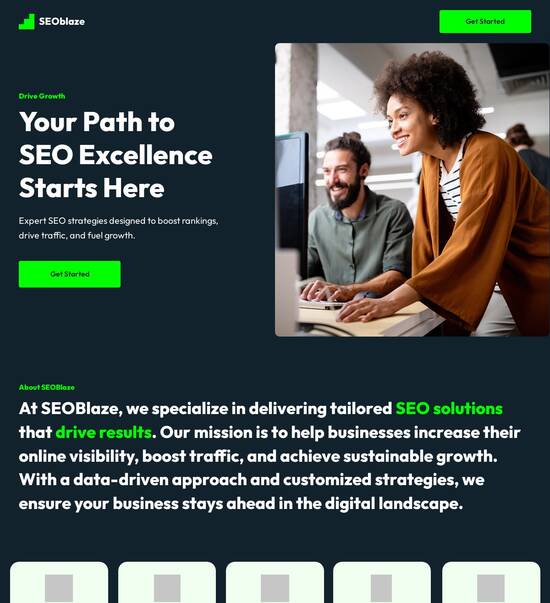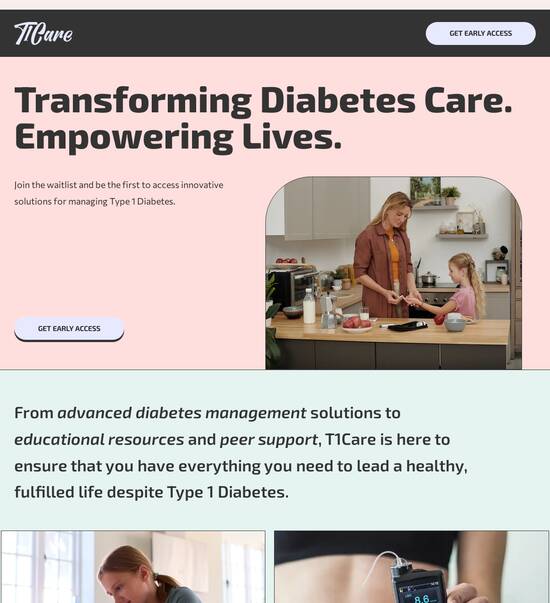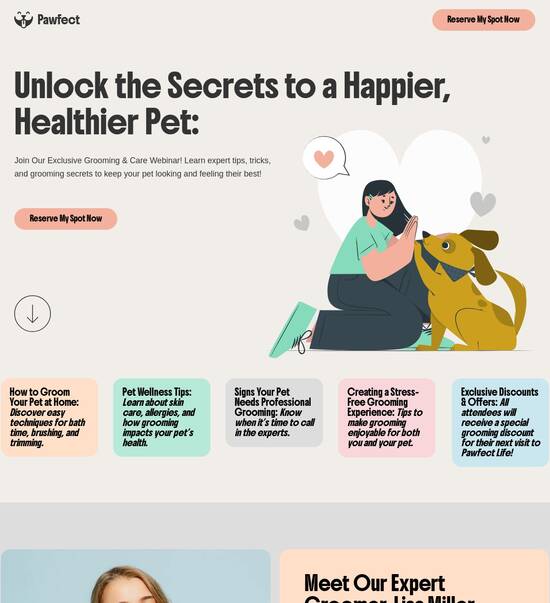
Web page template for 3D printing companies
Use TemplateAbout template
Give your 3D printing companies a boost with our professional landing page templates. Ready to turn visitors into customers?
Recommended templates

Easy to build without coding
With the intuitive drag-and-drop builder, anyone on your team can create high-converting pages without any knowledge of code or design. Make enhancements to your landing page with custom widgets using Javascript, HTML/CSS, or third-party scripts.

Multiple layouts for any industry and goal
Select from 500+ landing page layouts built to boost conversions across industry-specific scenarios. Customize them by adjusting fonts, adding images, and generating on-brand content with the AI assistant. Quickly scale with Instablocks® and Global Blocks that you can save, reuse, and update globally.

Loads fast and looks polished on any device
Every template is responsive, which means they present professionally on any device and load blazingly fast with our Thor Render Engine. You can also power them up with Google AMP technology to deliver an unparalleled mobile experience and drive higher conversions.

Robust analytics & experimentation
Get real-time updates and reporting across all your devices, showing the number of visitors, conversions, cost-per-visitor, and cost-per-lead. Launch AI-powered experiments, run A/B tests, and use heatmaps to analyze user behavior, then optimize your landing page to maximize conversions.







Easy to build without coding
With the intuitive drag-and-drop builder, anyone on your team can create high-converting pages without any knowledge of code or design. Make enhancements to your landing page with custom widgets using Javascript, HTML/CSS, or third-party scripts.
Multiple layouts for any industry and goal
Select from 500+ landing page layouts built to boost conversions across industry-specific scenarios. Customize them by adjusting fonts, adding images, and generating on-brand content with the AI assistant. Quickly scale with Instablocks® and Global Blocks that you can save, reuse, and update globally.
Loads fast and looks polished on any device
Every template is responsive, which means they present professionally on any device and load blazingly fast with our Thor Render Engine.
Robust analytics & experimentation
Get real-time updates and reporting across all your devices, showing the number of visitors, conversions, cost-per-visitor, and cost-per-lead. Launch AI-powered experiments, run A/B tests, and use heatmaps to analyze user behavior, then optimize your landing page to maximize conversions.
All the features you need to build 3d printing website template
Explore more featuresLearn how to build 3d web page design
Frequently asked questions about printing company website templates
Leading the way in building high-performing landing pages





3d printing website template free: Your ultimate how-to guide
Effective marketing campaigns rely on high-converting landing pages. With Instapage, you can access powerful tools that help you create something extraordinary. This guide will walk you through the process of using Instapage’s landing page templates designed specifically for enhancing conversions and driving results across various industries, including education, tech, and financial services.
Why use landing page templates for your marketing campaigns?
Using landing page templates simplifies the creation process and accelerates launch times. Instapage provides a library of over 100 high-converting templates tailored to various sectors such as business services and energy. This ensures that your campaigns can run smoothly, require less time to go live, and yield better results due to optimized designs.
- Instant setup: With ready-made templates, you can launch your campaigns faster.
- Proven designs: Templates are built on successful landing page principles, increasing the likelihood of conversions.
- Customizability: Templates can be easily personalized to align with your brand’s identity.
Step 1: Choose the right template
Start by selecting a template that closely matches your campaign objectives. Instapage offers diverse options for various marketing goals. Once you find a suitable template, you can leverage the drag-and-drop page builder for customization.
Step 2: Customize for your audience
Tailoring your landing page content is essential to improving engagement. Leverage Instapage’s personalization features like dynamic text replacement that adjusts content based on visitor information. Make sure to consider industry-specific language and visuals.
- Personalized CTAs: Craft calls-to-action that resonate with specific audience segments to improve conversion rates.
- Targeted messaging: Use language and visuals aligned with the desires and pain points of your visitors.
- A/B testing: Experiment with different versions of your page to see what works best for your audience.
Step 3: Optimize and analyze your performance
Once your landing page is live, focus on performance optimization. Instapage provides built-in analytics tools and A/B testing features that allow you to monitor visitor behavior and adjust your strategies accordingly.
- Heatmaps: Visualize how users interact with your page elements.
- Conversion tracking: Measure the effectiveness of your landing page with clear metrics.
- Iterative testing: Continuously improve your pages based on data-driven insights.
By implementing these steps, your use of Instapage will contribute greatly to enhancing your overall marketing outcomes and maximizing your ROI.
Ready to transform your landing pages and boost your conversions? Start your journey with Instapage today and explore the powerful features that will elevate your marketing efforts!
People also ask about printing website templates
Crafting an exceptional online presence: A comprehensive web page template for 3D printing companies
Understanding the unique needs of 3D printing companies
The 3D printing industry has emerged as one of the most innovative and rapidly expanding sectors in manufacturing and design. As technology continues to evolve, so does the range of services offered by 3D printing companies, catering to diverse applications from prototyping to final product manufacturing. With this growth, it's essential for companies to establish a robust online presence through a dedicated website.
Identifying the target audience is central to crafting an effective online strategy. Potential customers fall into different categories, including hobbyists interested in personal projects and businesses seeking large-scale production solutions. Understanding their demographics, preferences, and pain points enables 3D printing companies to tailor their marketing messages and service offerings.
Market growth and innovation
Diversity of services and applications
Hobbyists vs. businesses
Key demographics and preferences
Generating inquiries and customer orders
Displaying unique offerings and capabilities
Essential elements of a 3D printing company web page template
An effective web page template for 3D printing companies must feature a visually striking homepage layout that immediately captures the visitor's attention. High-quality images of prints can create an impactful first impression, while engaging hero sections can communicate the company's value uniqueness succinctly.
Navigation plays a crucial role in user experience; hence, a streamlined design ensures that visitors can easily navigate through the site. A logical menu structure that leads directly to essential sections like services, portfolio, and team not only enhances usability but also guides potential customers through their discovery process.
Utilizing high-quality images of prints
Engaging hero sections that capture attention
Intuitive menu design for seamless navigation
Easy access to essential sections: Services, Portfolio, and Team
Description of 3D printing services provided
Differentiation from competitors
Maximizing engagement through innovative features
To boost engagement, incorporating interactive elements on the web page is essential. Features such as 3D model viewers allow visitors to explore prints in detail, providing a hands-on experience that encourages interest. Additionally, embedding request-a-quote forms makes it easy for potential clients to inquire about services, streamlining the communication process.
Testimonials and reviews are vital components that build trust. Featuring feedback from satisfied customers validates the company's expertise and assures prospective clients of its capabilities. Moreover, a blog containing educational resources about 3D printing technology can address common questions, positioning the company as an authority in the field.
3D model viewers for showcasing prints
Request a Quote forms for inquiries
Building trust through social proof
Highlighting successful collaborations and projects
Sharing insights on 3D printing technology
Addressing common questions from potential clients
Optimizing for conversions: Turning visits into customer orders
To convert visitors into leads, the web page must feature essential calls to action (CTAs) positioned strategically throughout. These CTAs prompt users to inquire about services, thereby enhancing the likelihood of generating customer orders. Additionally, simplifying the order process is crucial; this includes providing clear navigation to order forms and detailed instructions for custom projects.
Integrating contact information for the support team across multiple channels—live chat, email, and phone—ensures that potential clients can easily reach out for assistance. Complementing this with a FAQ section not only addresses common inquiries but also helps in providing clarity to customers, further improving conversion rates.
Strategically placed buttons for inquiries
Encouraging newsletter sign-ups for updates
Easy navigation to order forms
Clear instructions for custom projects
Multi-channel support: Live chat, email, phone
Providing a FAQ section to ease customer inquiries
Harnessing technology for a competitive edge
Implementing SEO best practices specific to the 3D printing industry is critical for driving organic traffic. Keyword optimization in service descriptions enhances discoverability, while technical SEO improvements like boosting site speed and ensuring mobile-friendliness can significantly affect user experience.
Utilizing analytics tools to monitor visitor behavior offers valuable insights that can guide ongoing updates to the website. A robust content management system (CMS) can streamline the process of managing site content, making it easier for companies to keep their websites relevant and aligned with business growth.
Keyword optimization for service offerings
Technical SEO improvements (site speed, mobile-friendliness)
Tools for monitoring visitor behavior
Insights for continuous improvement of website performance
User-friendly systems for managing content
Options for scalability as businesses grow
Showcasing your team: Humanizing your brand
An effective team section can humanize a 3D printing company, showcasing the people behind the technology. A well-designed layout featuring profiles of team members helps establish transparency. Each profile can outline individual skills and backgrounds, which not only fosters a connection with potential clients but also highlights the team's collective expertise.
Highlighting individual specialties and experiences reinforces credibility. Clients want to know they are collaborating with knowledgeable professionals, and sharing insights about team members' experiences can significantly differentiate a business from competitors.
Importance of transparent team representation
Profiles showcasing skills and backgrounds
Individual specialties and experiences
Building credibility through knowledge sharing
Final touches to elevate your online presence
Brand consistency is essential in a web page template for 3D printing companies. Maintaining cohesive color schemes and fonts across the website helps reinforce brand identity, while utilizing branding elements consistently throughout is crucial for recognition.
Considering the mobile user experience is paramount; thus, ensuring that the website is responsive across all device types promotes accessibility. Techniques like adaptive images and fluid layouts can effectively enhance responsiveness. Lastly, implementing strategies for regular content updates and design revisions can keep the website fresh and engaging.
Cohesive color schemes and fonts
Utilization of branding elements across pages
Importance of mobile optimization in user experience
Techniques for ensuring responsiveness
Scheduled updates for content and technology
Regularly revisiting design elements to keep fresh
Ready to skyrocket conversions?
Supercharge your ad campaigns with high-performing landing pages
Get started














